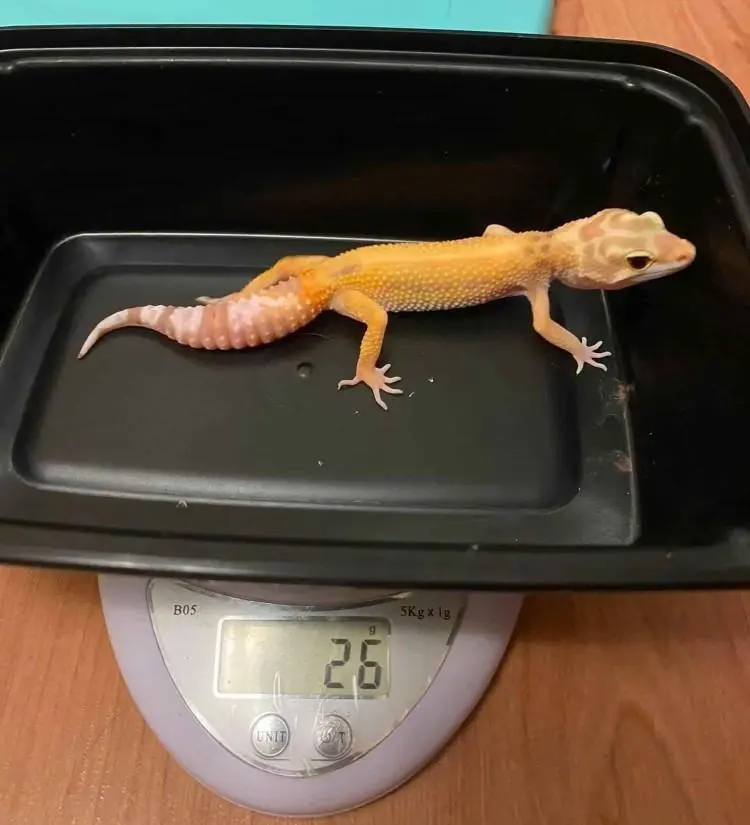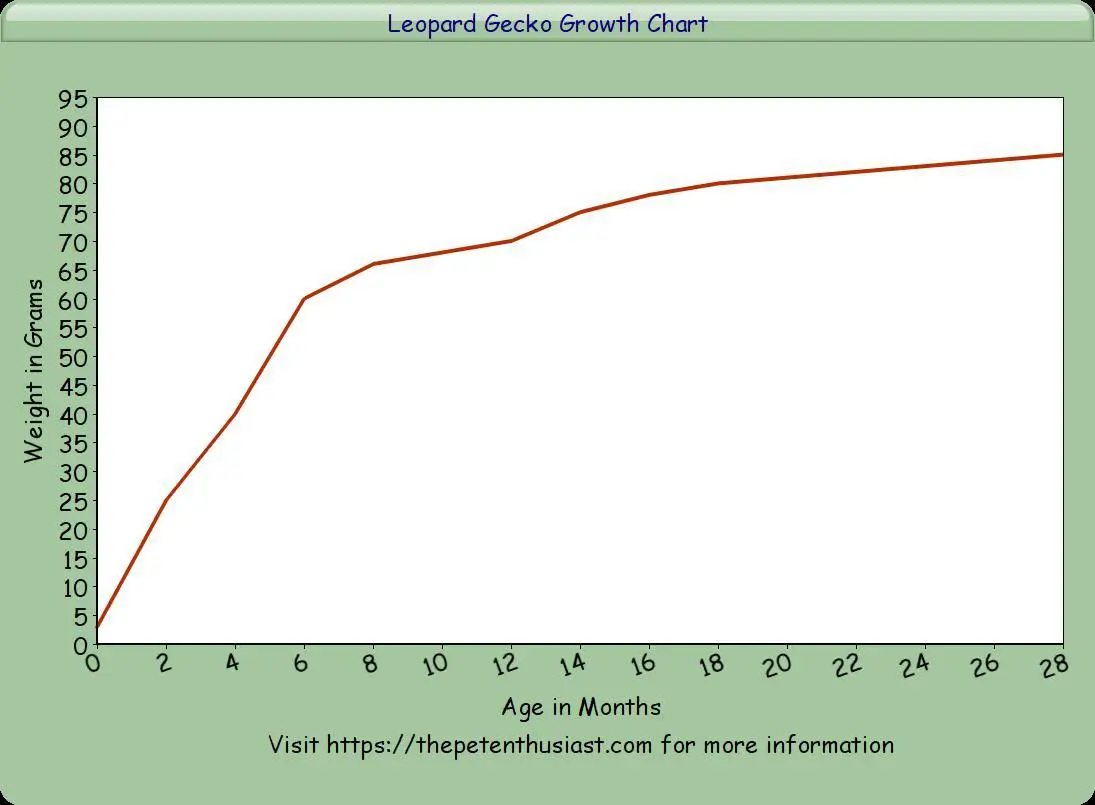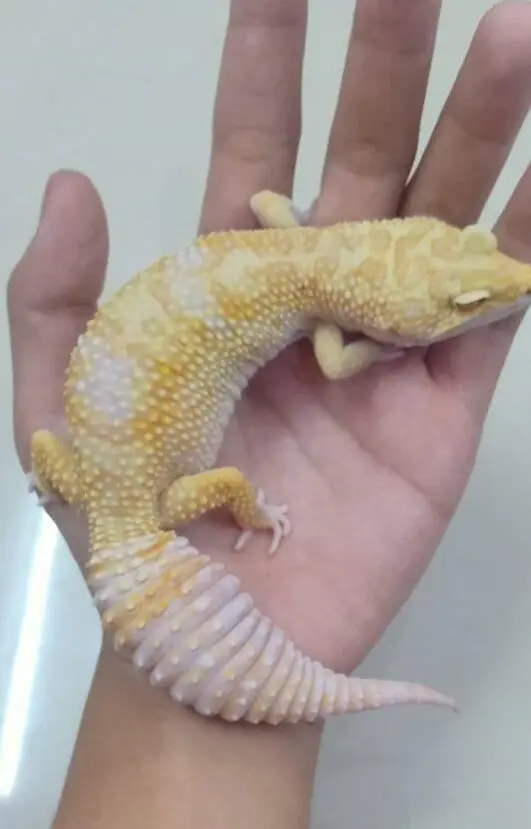Geckos are smaller lizards, but you will still want some indication on how big your gecko is going to grow.
Knowing the accurate weight by age, you can ensure your gecko is healthy and at a good weight.
Continue reading below to find out about the leopard gecko growth chart, how is the growth rate of a leopard gecko from hatching to adult.
You can quickly identify if your leopard gecko is over or underweight, along with what factors to take into consideration to ensure your pet has a happy and healthy life.
How to Measure a Leopard Gecko’s Weight?

- Use a digital food scale with a bowl to reduce the risk of escape, such as the Etekcity Food Scale with Bowl, which offers accurate measurements that are reliable and precise. Measure 2g to 5000g with confidence
- Measurements must be in grams
- Weigh your gecko monthly
Leopard Gecko Growth Chart

Leopard gecko growth chart
|
Age | Weight |
|---|---|
|
Hatching | 3 – 4.5 grams |
| 1 month |
15 – 20 grams |
|
2 months | 18 – 30 grams |
| 4 – 6 months |
25 – 60 grams |
|
9 – 18 months |
40 – 110 grams |
When is a Leopard Gecko a Baby?
A leopard gecko is considered a baby when they measure up to 3 grams in weight.
When is a Leopard Gecko a Juvenile?
Juvenile leopard geckos are young geckos that measure anywhere from three grams to 30 grams.
Your gecko remains a juvenile for ten months.
When is a Leopard Gecko Fully Grown?
A leopard gecko is considered an adult when they reach twelve months of age or around 40 grams.
They can continue growing up to approximately 120 grams.
How Long Does it Take for a leopard gecko to grow?
A leopard gecko can continue growing for eighteen months from birth.
Most geckos will reach their fully grown weight by the time they are one and a half years of age.
When do they grow fast?
You will notice that your gecko will grow the fastest from four to six months of age, during this time they can grow almost thirty grams in only two months.
When do they stop growing?
Your leopard gecko should stop growing by the time it reaches one and a half years of age (18 months).
What is The average weight of a full grown leopard gecko?
Not all leopard geckos are the same, some grow more than others.
The average weight of a fully grown leopard gecko is 60 grams.
How do I know if my leopard gecko is too skinny?
If your leopard gecko weighs under 40 grams when fully grown, then it is considered underweight.
You will notice that the head appears bigger than the body, while the tail looks thin and small.
How do I know if my leopard gecko is overweight?

Overweight leopard gecko
A leopard gecko that is overweight will have fat rolls on its body.
The base of the tail will be thick. The tail will be as wide or even wider than the width of the head.
Overweight geckos are not uncommon in captive environments.
Some Development Stages
When Does a Leopard Gecko First Start Shedding?
A leopard gecko will shed for the very first time when they are between five and seven days of age.
From hatching, they will shed every ten days or so and that slows to every four to six weeks once they reach adulthood.
At What Age Do Leopard Geckos Start Brumation?
Brumation is a type of hibernation experienced in leopard geckos from around one year of age.
In the wild, they will brumate during the cooler months of the year. This is a natural part of your gecko’s life cycle.
You will when your gecko is a year in age and you head into winter it may be less active, stop eating as much and even hide for a few weeks at a time.
Most geckos will also choose the cool side of the enclosure over the warm side during the brumation period.
When Can I Tell If My Leopard Gecko is Male or Female?
You should be able to start identifying your gecko’s sex by the time they reach six months.
There are two telltale signs you are looking for:
- Pre anal pores are found in male leopard geckos showing a V-shaped row of pores, found just in front of their vent. These pores become more prominent with age. Even though the female will also have these pores, they are not as obvious.
- Hemipenile Bulges are found in male geckos and are two very distinct bulges just behind the vent.
When Are Leopard Gecko’s Ready to Be Bred?
You are going to want to wait for your leopard gecko to reach at least one year in age before you consider breeding.
Breeding is relatively easy, but if your female is too young, complications may develop and you can shorten your gecko’s lifespan.
Females must be healthy, not underweight, and should be a minimum of fifty grams.
Remember female leopard geckos will lose weight during egg production.
Factors That Impact Growth and Size
Poor habitat conditions
Incorrect size enclosure – you need a minimum of 20 gallons
Inaccurate temperatures – temperatures should be between 75ºF and 89ºF
Inaccurate humidity levels – humidity should be maintained between 30% and 40%
Wrong substrate – Impaction is a serious problem with geckos. Reptile carpet, tiles, shelf liners are safe and reduces the risk of impaction
Hides – your gecko wants its privacy and to feel secure, provide a cool and warm hide to ensure overall health in your reptile pet
Poor diet – a leopard gecko should enjoy a varied diet of crickets, mealworms, cockroaches, and more.
Parasites are known to have a negative impact on the leopard geckos’ weight. Diarrhea, weight loss, reduced grown are all signs of parasites.
Crypstosporidia is associated with a small intestinal epithelial hypertrophy that can reduce the ability to grow. It also results in rapid weight loss.
Metabolic bone disease is a nutritional disease that can reduce in slow growth. This is due to captive geckos not having the right factors to metabolite calcium, which results in demineralization in the bones. This is a common problem in leopard geckos in captivity.
UVB lighting, calcium supplements, and vitamins can reduce the risk of metabolic bone disease in your reptile pet.
Summary
As a leopard gecko owner, you want the best for your reptile pet. When you are in the position to be able to compare the weight to age, you can ensure you have a healthy pet on your hands.
Being able to quickly identify a low weight or overweight gecko, can help you make the necessary changes to promote healthy and ensure your gecko lives to a healthy age of around fifteen years.
oh cool so cool
My gecko is happy now